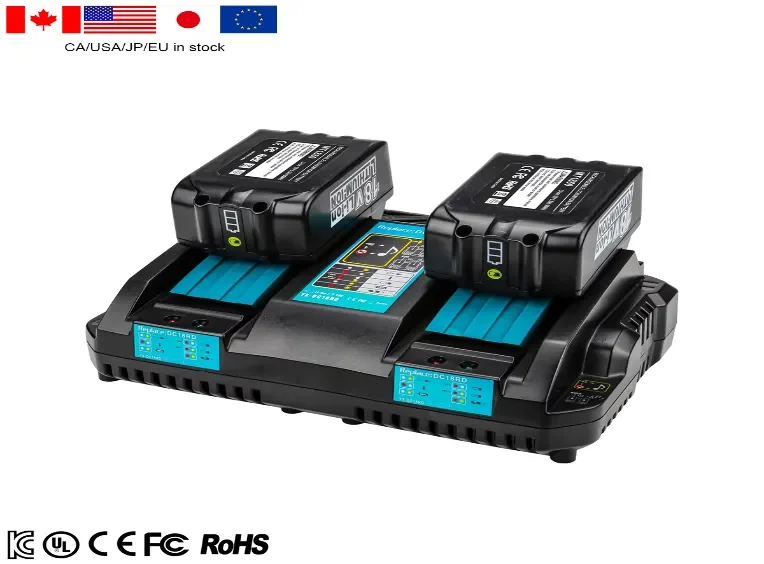Can a Makita 18V Charger Charge a 12V Battery?
Makita’s 18 V LXT chargers (e.g. DC18RC, DC18RD) are built exclusively for three‑cell (nominal 18 V) lithium‑ion packs—they use a charging algorithm, cell‑balancing routine and safety cut‑outs tailored to 18 V chemistry and require a proprietary SMBus handshake. A 12 V CXT pack only has two cells and different contacts, so the charger won’t recognize it, refuse current flow and shut down for safety. Attempting cross‑charging risks cell damage, BMS faults or fire. Always use a Makita 12 V charger (e.g. DC10WA) for 12 V packs and reserve LXT chargers for 18 V batteries.

No—Makita’s 18 V LXT chargers are designed specifically for the 18 V battery chemistry, voltage and pin configuration, so they will neither recognize nor properly charge a 12 V pack. The charging algorithm, cell‑balancing routines and safety cut‑outs built into models like the DC18RC or DC18RD expect three cells in series (nominal 18 V), whereas a 12 V battery only has two cells in series; this voltage mismatch prevents the charger from initiating any current flow. Physically, the latch rails and contact plate geometry on 12 V batteries differ from the LXT interface, so even if you could force a seating, the charger’s safety diagnostics would detect an unsupported pack and refuse to charge. Always use the Makita 12 V charger (e.g. DC10WA) for your 12 V batteries and reserve the LXT chargers exclusively for 18 V packs to ensure correct voltage delivery, proper cell balancing and the built‑in thermal protections your batteries rely on.
Many users wonder if their Makita LXT (18 V) charger can top off CXT (12 V) packs. Short answer: No. The two systems are intentionally kept separate for safety and performance. Below is a concise explanation:
Why an 18 V Charger Won’t Charge a 12 V Battery
An 18 V charger is engineered specifically for three‑cell (18 V nominal) lithium‑ion packs—its charging algorithm, cell‑balancing routines, and safety cut‑offs expect the voltage profile and chemistry of an 18 V LXT battery. A 12 V pack contains only two cells in series, so the charger’s voltage detection won’t recognize the lower voltage and will refuse to initiate current flow. Mechanically, the contact plate geometry and latch rails on a 12 V pack differ from the 18 V interface, and even if you could force a seating, the charger’s diagnostics would detect an unsupported pack and shut down to prevent over‑voltage or improper cell balancing. Always match Makita charger voltage to your battery platform—use 12 V chargers for 12 V packs and 18 V chargers for 18 V packs—to ensure safe, correct charging.
1. Voltage Mismatch
18 V Chargers deliver up to 21.6 V during the constant-voltage phase.
12 V Packs peak at 12.6 V.
Applying 21.6 V to a 12.6 V pack damages cells and triggers BMS protection.
2. BMS Handshake Incompatibility
- Both LXT and CXT use proprietary SMBus handshakes.
- An 18 V charger expects a 5-cell (LXT) BMS signature.
- A 3-cell (CXT) pack sends a different protocol, causing the charger to refuse or error out.
3. Physical Incompatibility
- CXT battery terminals are keyed differently and spaced to prevent insertion into LXT chargers.
- Forcing a CXT pack into an 18 V socket can bend contacts or damage both charger and pack.
Risks of Cross-Charging
1. Cell Damage & Capacity Loss: Over-voltage stresses cells, reducing lifespan.
2. BMS Faults: Frequent lock-outs or permanent disablement.
3. Safety Hazards: Risk of overheating, swelling, or fire if BMS fails.
How to Properly Charge 12 V and 18 V Packs
Use Dedicated 12 V Chargers: Models DC10WC or DC10SB apply the correct 12.6 V/1.5 A profile.
Use LXT Chargers for 18 V Packs Only: DC18RC, DC18SD, DC18RD support 18 V (21.6 V peak) LXT packs.
Multi-Port Option: Makita BCV02 automatically detects and charges both 12 V and 18 V packs safely.
Best Practices for Charger Use
Operating Temperature: 5°C–40°C—chargers pause outside this range.
Clean Contacts Monthly: Wipe terminals on both charger and battery with isopropyl alcohol.
Prompt Removal: Remove the pack within 10 minutes of the full-green LED to avoid trickle stress.
FAQ
Q: Can I trick an 18 V charger to charge 12 V packs with adapters?
A: No—voltage regulators can’t replicate Makita’s BMS handshake, and adapters bypass key safety interlocks.
Q: Will a 12 V charger charge my 18 V pack partially?
A: A 12 V charger won’t reach the voltage needed for a 5-cell pack, leaving it undercharged and potentially confusing the BMS.
Q: How to identify my charger’s supported voltage?
A: Check the model label (e.g., DC18RC for 18 V) and the output specs on the charger housing.
Looking for the right charger? Compare Makita’s DC10WC (12 V), DC18RC/SD/RD (18 V), and BCV02 multi‑port station in our detailed comparison table—covering charge times, diagnostics, and compatibility.